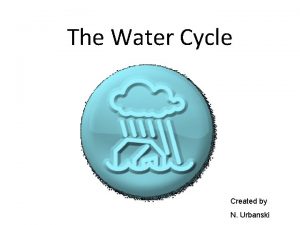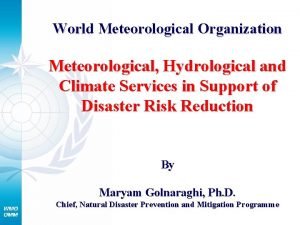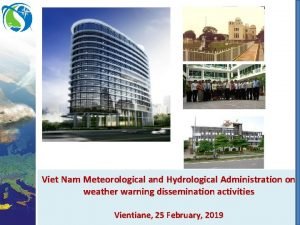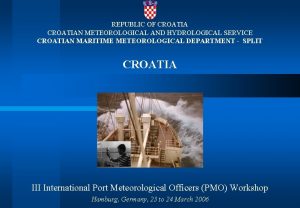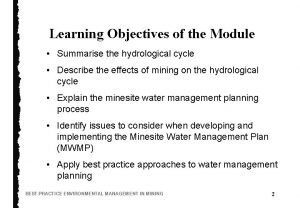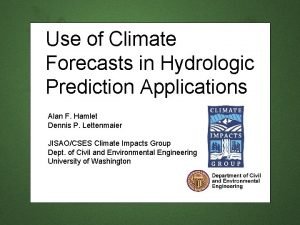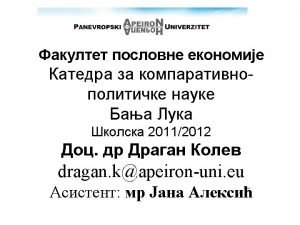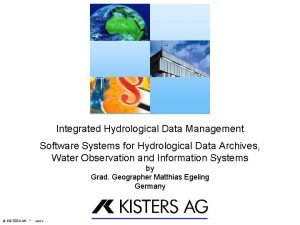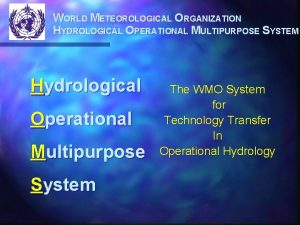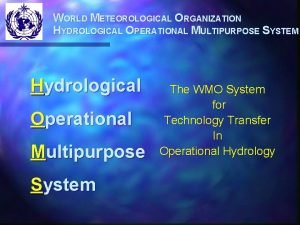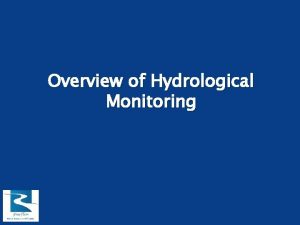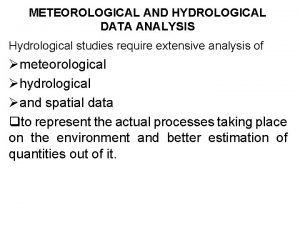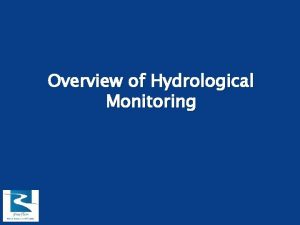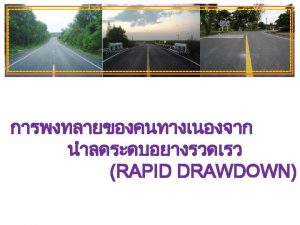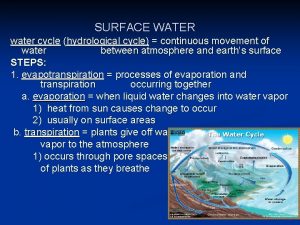Projected changes in the hydrological cycle Goran Pejanovi





![A 2 scenario projected changes [2071 -2100][1961 -1990] seasonal accumulated precipitation seasonal average 2 A 2 scenario projected changes [2071 -2100][1961 -1990] seasonal accumulated precipitation seasonal average 2](https://slidetodoc.com/presentation_image_h2/779d696e95d25d9a77aec1109e81378f/image-6.jpg)


![Change in mean seasonal river flow [2071 -2100]-[1961 -1990] Projected changes in river flow Change in mean seasonal river flow [2071 -2100]-[1961 -1990] Projected changes in river flow](https://slidetodoc.com/presentation_image_h2/779d696e95d25d9a77aec1109e81378f/image-9.jpg)







- Slides: 16

Projected changes in the hydrological cycle Goran Pejanović Director of South East European Virtual Climate Change Center, hosted by National Hydrometeorological Service of Serbia www. seevccc. rs

Background ● Main water users: Hydrological cycle changes agriculture, industry, energy, householders ● Water availability problem in Europe: water and population are unevenly distributed subregions have different degree of water stress ● South-eastern Europe, Mediterranean and Alps are most sensitive to climate changes ● Water-related climate change impacts: higher freshwater demand, especially for irrigation more frequently and severe floods and droughts larger soil erosion reduce in water quality decrease in groundwater resources salt water intrusion in coastal aquifers impact on aquatic ecosystems increase in risks of water-transmissive diseases ● In general, annual water availability will increase in northern and north-western Europe and decrease in southern and south-eastern Europe.

Observed changes in 2 m temperature (1976 -2006) ● annual increase in temperature warm spells frost days ● larger increase: on north and mountains during winter on south and coastal areas during summer ● increase in warm spells duration in summer ● decrease in number of frost days during winter ● increase in duration of vegetation growing period Observed 2 m temperature for period 1976 -2006 ( annual winter summer °C / decade)

Observed changes in precipitation (19612006) ● precipitation change is more ● contribution of heavy rainfall spatially heterogeneous ● annual and winter precipitation: increase on north decrease on south ● summer precipitation: decrease on north larger decrease on south Observed annual precipitation change ( mm / decade ) increased in most of the regions ● number of days with heavy rain: increase on north decrease on south ● decrease in number of days with snow fall on mountains Observed change in contribution of heavy rainfall ( % / decade )

Projected changes of temperature and A 1 B scenario projected changes A 2 scenario projected changes precipitation annual accumulated precipitation annual average 2 m temperature [2001 -2030]-[1961 -1990] [2071 -2100]-[1961 -1990]
![A 2 scenario projected changes 2071 21001961 1990 seasonal accumulated precipitation seasonal average 2 A 2 scenario projected changes [2071 -2100][1961 -1990] seasonal accumulated precipitation seasonal average 2](https://slidetodoc.com/presentation_image_h2/779d696e95d25d9a77aec1109e81378f/image-6.jpg)
A 2 scenario projected changes [2071 -2100][1961 -1990] seasonal accumulated precipitation seasonal average 2 m temperature winter season changes summer season changes

Projected changes of snow cover and soil moisture according to A 2 IPCC/SRES scenario Change in days with snow cover [2071 -2100]-[1961 -1990] Change in soil moisture [2071 -2100]-[1961 -1990]

Projected return period of droughts with an intensity of today’s 100 -years events (A 2 IPCC/SRES scenario) Projected drought return period
![Change in mean seasonal river flow 2071 21001961 1990 Projected changes in river flow Change in mean seasonal river flow [2071 -2100]-[1961 -1990] Projected changes in river flow](https://slidetodoc.com/presentation_image_h2/779d696e95d25d9a77aec1109e81378f/image-9.jpg)
Change in mean seasonal river flow [2071 -2100]-[1961 -1990] Projected changes in river flow (A 2 IPCC/SRES scenario)

Projected changes in river flow ● Projected changes in river flow strongly depend on changes in precipitation, but its connection is not linear The Danube river flow ● Less snow on mountains during winter => less snow melt in spring => shift in flow regime ● Less precipitation during winter => decrease in ground water => decrease in summer flow in rivers that strongly depend on ground water [1961 -1990] [2071 -2100] ● Increase in temperature => longer vegetation growth period => increase in evapotranspiration => lower groundwater recharge ● decrease in summer minimum flow ● shift in maximum flow toward winter and autumn ● prolonged maximum and minimum flows duration

HYPROM as a tool for water resources assessment ● atmosphere: NMMe non hydrostatic model ● land: NOAH land surface scheme ● hydrology: HYPROM 2 D surface runoff HYPROM 1 D river routing ● dynamical treatment of an overland flow ● suitable for long term and flash flood simulations ● computationally efficient Datasets: HYDRO 1 k USGS topography FAO soil texture data USGS land use data

The Savinja river (Slovenia) – flash flood case study T and V at 850 h. Pa, 1 Nov 1990 river discharge (m^3/s) accumulated precipitation (mm) model. vs. observations accumulated rainfall 26 Oct - 6 Nov 1990 forecast hour (h)

The Moraca river (Montenegro) – case study Water budget components six months accumulations [Nov 2002 – Apr 2003] Moraca basin: 2600 km 2 precipitation snow melt evaporation runoff

The Moraca river - surface runoff An example of heavy rain event 5 Feb 2003 7 Feb 2003

The Moraca river discharge model. vs. observations year 2003 year 2008 climate change projections 2020 -2030

Thank you! www. seevccc. rs
 Non projected
Non projected Condensation process example
Condensation process example Four parts of the water cycle
Four parts of the water cycle National meteorological and hydrological services
National meteorological and hydrological services Vietnam meteorological and hydrological administration
Vietnam meteorological and hydrological administration Croatian meteorological and hydrological service
Croatian meteorological and hydrological service Hydrological
Hydrological Hydrological prediction center
Hydrological prediction center Changes in latitudes, changes in attitudes meaning
Changes in latitudes, changes in attitudes meaning Physical changes vs chemical changes
Physical changes vs chemical changes Goran repinc
Goran repinc Epika ponavljanje
Epika ponavljanje Goran milas
Goran milas Goran vesi
Goran vesi Hipertenzija kod mladih
Hipertenzija kod mladih Distorsio art
Distorsio art Smb protokol
Smb protokol


